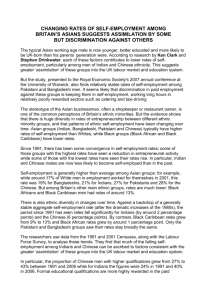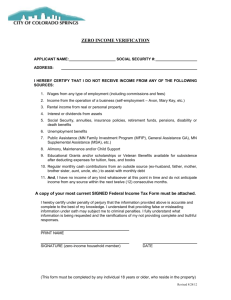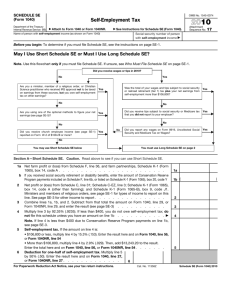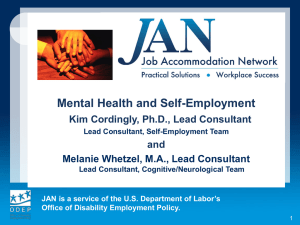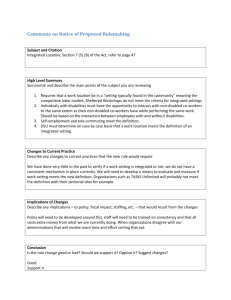31. Self-Employment
advertisement
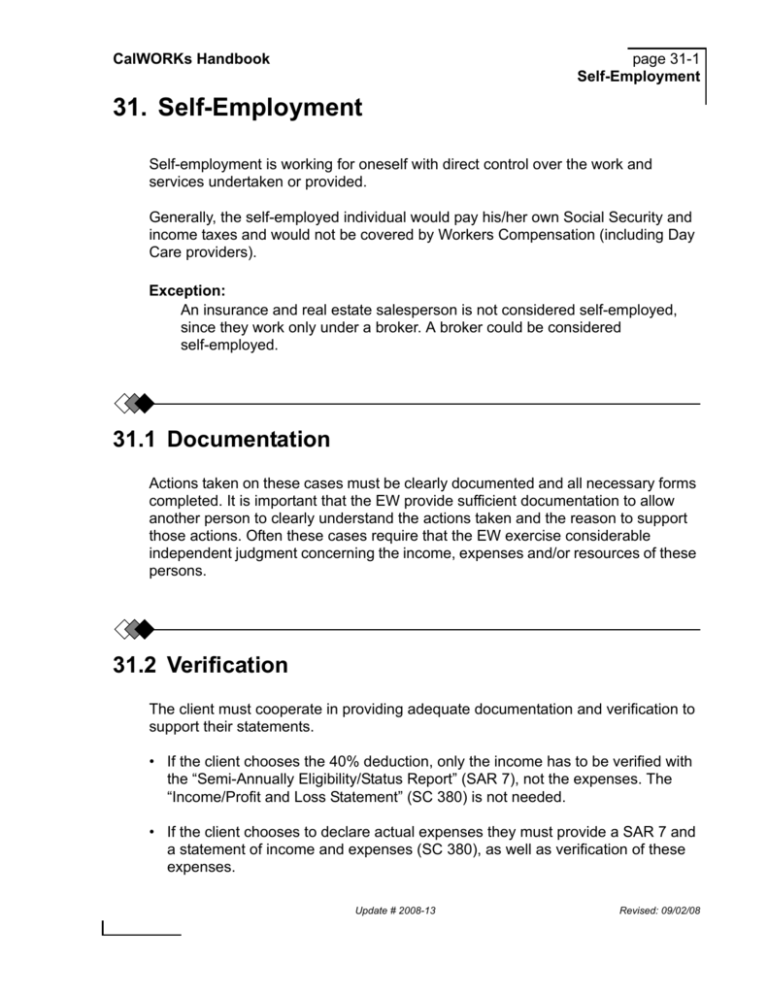
CalWORKs Handbook page 31-1 Self-Employment 31. Self-Employment Self-employment is working for oneself with direct control over the work and services undertaken or provided. Generally, the self-employed individual would pay his/her own Social Security and income taxes and would not be covered by Workers Compensation (including Day Care providers). Exception: An insurance and real estate salesperson is not considered self-employed, since they work only under a broker. A broker could be considered self-employed. 31.1 Documentation Actions taken on these cases must be clearly documented and all necessary forms completed. It is important that the EW provide sufficient documentation to allow another person to clearly understand the actions taken and the reason to support those actions. Often these cases require that the EW exercise considerable independent judgment concerning the income, expenses and/or resources of these persons. 31.2 Verification The client must cooperate in providing adequate documentation and verification to support their statements. • If the client chooses the 40% deduction, only the income has to be verified with the “Semi-Annually Eligibility/Status Report” (SAR 7), not the expenses. The “Income/Profit and Loss Statement” (SC 380) is not needed. • If the client chooses to declare actual expenses they must provide a SAR 7 and a statement of income and expenses (SC 380), as well as verification of these expenses. Update # 2008-13 Revised: 09/02/08 page 31-2 Self-Employment 31.2.1 CalWORKs Handbook Deprivation If the principal earner is self-employed and works less than 100 hours monthly, “U” parent deprivation may be available based on the number of hours worked. For example, they may meet a deprivation basis of unemployed if they work less than 100 hours a month. Once U-Parent deprivation is determined, deprivation is not affected if the recipient increases their hours of self-employment. The EW must explore the client's ability to work more hours and the need for the type of work that the client performs. This may often be based upon: • An examination of the client's past business records. • The expectation of future business. • The client's sworn statement, using the “General Affidavit” (SC 101). 31.2.2 Work Registration In determining the work registration requirement for a self-employed person, the EW must use the same criteria for any other employed person. 31.3 Determination of Self-Employment The following criteria offer guidelines in defining self-employment, but are not all inclusive or inflexible. The self-employed person: Filed taxes as self-employed the previous year and is in the same type of self-employment at the time of application. (This could include the person that works for his/her own business and the business files as such.) OR Who did not file as self-employed the previous year because they are newly self-employed or for some other reason did not meet the above criteria, may still be considered self-employed. OR Revised: 09/02/08 Update # 2008-13 CalWORKs Handbook page 31-3 Self-Employment Commonly offers his/her services or merchandise to ANYONE who may be in the market for them; AND • Commonly provides HIS/HER OWN supplies, materials or merchandise; AND • Is responsible for expenses normally paid by an employer. Note: A self-employed person may meet the definition of U parent for CalWORKs application purposes. For example, a self-employed gardener who was only able to find 50 hours a month employment could be classified “unemployed.” 31.4 Examples of Self-Employment Determinations 31.4.1 Day Care Provider A client may be self-employed as a provider of child care. It does not matter whether or not the individual is licensed. Examples of this are as follows: • A woman advertises (on bulletin boards, in newspapers, by word of mouth, etc.) that she will keep children in her home for pay. She provides snacks and toys as well as care and supervision. She is self-employed. • A woman babysits in the child's home for pay. She does not provide anything except her services. She may be “on call” for several persons. She is an employee with wages, possibly several employers, but is not self-employed. 31.4.2 Housekeeper Individuals are self-employed if they offer housekeeping services to the general public, performing specific jobs for specific pay, and providing their own supplies and equipment. If the housekeeper routinely works in the employer's home, using the employer's equipment and supplies, that individual is an employee with wages. Update # 2008-13 Revised: 09/02/08 page 31-4 Self-Employment 31.4.3 CalWORKs Handbook Room and Board All income from room and board or room rental is considered self-employed income. The actual amount received minus any allowable business expenses is counted as earned income to the AU. [Refer to “Income from Property”, Section 28.13.] 31.4.4 Salesperson A person who buys products for resale (including buying raw materials for manufacture of products for sale), or accepts products on consignment for sale is self-employed. A person who sells products or services for another, or for a business, is an employee, regardless of whether a salary, commission, or some combination is received. 31.4.5 Independent Production Independent production is making merchandise independently from the constraints of another regarding work conditions, hours worked, etc. Such production usually consists of craft type articles, such as pottery, leather goods, art work, sewing, etc., and will usually, but not always, be done in the person's home. If an individual buys raw materials and retains the sales profit, this person is self-employed, whether the product is sold to the general public or to a person or company. If an individual produces a product from materials provided by others and is paid a fixed amount (piece work rates, salary, etc.), this person is an employee. 31.4.6 Odd Jobs A person may do one or several odd jobs, on a regular or irregular basis, and may or may not offer services to the general public. Personal tools or equipment (as opposed to supplies and materials) may or may not be used. • Individuals who provide their own supplies or materials are self-employed. • If the individual is specifically reimbursed for the cost of supplies or materials in addition to pay, or if supplies and materials are provided, then that individual is an employee. Revised: 09/02/08 Update # 2008-13 CalWORKs Handbook 31.4.7 page 31-5 Self-Employment Gardeners A gardener who operates independently, uses his own tools and equipment, provides plant sprays, plant food, etc., and takes the profits or losses is self-employed. An employee is a gardener who uses the home owner's tools, equipment, plant sprays or plant food and only provides the physical work and gardening knowledge. 31.5 Property and Resource Determination 31.5.1 Real Property Equity interest in real property is determined by subtracting any allowable encumbrance against its MARKET VALUE. Real property used as the home is exempt. Other real property must meet the criteria to be excluded [Refer to “Property”, Section 14.5.1 for a complete discussion of excluded real property and excess real property.] 31.5.2 Personal Property Items which are necessary to implement and continue an approved plan of employment are exempt. This includes, but is not limited to: • • • • Tools Equipment Materials Stocks and inventories Update # 2008-13 Revised: 09/02/08 page 31-6 Self-Employment CalWORKs Handbook 31.6 Income Determination [44-113.212] 31.6.1 Monthly Net Income AUs that receive self-employment income on a monthly basis must report the actual amount of such income on the “Semi-Annual Eligibility/Status Report” (SAR 7) for the Data Month. The AU’s benefit level for the SAR Payment Period is calculated based on the actual amount of self-employment income reported on the SAR 7 and anticipated income for each month of the following SAR Payment Period. Determine the net self-employment income reasonably anticipated to be earned from self-employment during each month of the SAR Payment Period by offsetting the reasonably anticipated monthly business expenses against the reasonably anticipated monthly gross income from self-employment. The applicant or recipient who is self-employed can choose a standard 40 percent deduction or the anticipated actual averaged cost of producing the self-employment income as business expenses. 31.6.2 Averaging Income AUs which receive self-employment income on a monthly basis must report the actual amount of such income on the Semi-Annual report (SAR 7). All anticipated gross self-employment income (including capital gains) expected for each month of the payment period is added and than averaged over the SAR Payment Period, and exclude the averaged anticipated cost of doing business or the 40% standard deduction for business expenses. Self-employment income received less often than monthly which represents an AU’s annual income must be averaged over a 12-month period even if the AU receives income from other sources in addition to self-employment. The annualized monthly income figure is used as the averaged income for the SAR Payment Period. Self-employment income which is intended to meet the AU’s needs for only part of the year must be averaged over the period of time the income is intended to cover. Individuals who are self-employed only part of the year and supplement their income from other sources during the balance of the year must have their self-employment income averaged over the period of time they are self-employed rather than a 12-month period. Revised: 09/02/08 Update # 2008-13 CalWORKs Handbook page 31-7 Self-Employment If an AU’s self-employment enterprise has been in existence for less than a year the income from that self-employment enterprise must be averaged over the period of time the business has been in operation, and that amount budgeted monthly. If the income is from a family member’s self-employment in farming or a fishing operation, and irregular expenses are incurred to produce that income, the family must have the option to average the expenses and related income over a 12-month period. 31.6.3 Annualized At the time of application, the income and expenses from a self-employment enterprise must be verified for either the last year or the last period during which income was earned and which was intended to cover either a year or a part of a year. This verified information is used to average the client’s income over the next year or period of time the income is intended to cover. If the client has experienced a substantial increase or decrease in business income, and the client can provide verification of the increase or decrease; then the averaged self-employment income must be calculated based on the anticipated earnings rather than on prior income. self-employment income that has been annualized for the current budgeting period must be redetermined in the following instances: • The client will likely experience or has experienced a substantial decline in income due to a change in circumstances such as crop failure or bankruptcy • The client reports increases or decreases in self-employment income that are outside what is normal for the particular season or trade • The client provides verification of self-employment expenses which the client incurred to produce the income, but had previously failed to report. Note: In determining a client’s averaged self-employment income only consider income and expenses which have been verified. At the time of redetermination, the actual self-employment income and expense information reported and verified with the family’s SAR 7 is used to average and project the family’s circumstances for the next year. The annualized method is not used often. Update # 2008-13 Revised: 09/02/08 page 31-8 Self-Employment 31.6.4 CalWORKs Handbook Migrant Farmworkers Migrant farmworker’s self-employment income is calculated on an anticipated basis. Add any capital gains the client anticipates it will receive in the next 12 months, starting with the date the application is filed, and divide this amount by 12. This amount is used in the successive 12 months, except that a new average monthly amount is calculated over this 12 month period if the anticipated amount of capital gains changes. Then add the anticipated monthly amount of capital gains to the anticipated monthly self-employment income. Either the 40% deduction is allowed or the actual cost of producing the self-employment income is calculated by anticipating the monthly allowable cost of producing the self-employment income. 31.6.5 Income Guide Use the following chart to determine how to calculate self-employment income: 31.6.6 If income is received... Then the self-employment income... Monthly, Is calculated monthly (even if it fluctuates from month to month). Less often than monthly which represents annual income, Must be averaged over a 12 month period. Less often than monthly and intended to meet the needs for only part of the year, Must be averaged for only the part of the year it is intended to cover. Deductions The client will have a choice when determining net self-employment income as to whether they claim: • The 40% deduction from gross self-employment income, OR • Actual verified expenses to be deducted from gross self-employment income. Once the self-employed client chooses a method of determining their self-employed net income, the client cannot alter that methodology until the next reinvestigation or every six months, whichever occurs sooner. Revised: 09/02/08 Update # 2008-13 CalWORKs Handbook 31.6.7 page 31-9 Self-Employment Capital Gains The proceeds from the sale of capital goods or equipment must be calculated in the same manner as a capital gain for Federal Income tax purposes. Even if only 50% of the proceeds from the sale of capital goods or equipment is taxed for federal income tax purposes, the full amount of the capital gain is counted as income. 31.6.8 Forms When the EW does the self-employed determination, use the following forms: • “Preliminary Self-Employment Questionnaire,” (SC 1250) to obtain basic information about the client's business, and the choice the client made in the method of income deductions, AND • “Self-Employment Sworn Statement” (CSF 35) to provide specific information about the client's income and expenses. Note: The CSF 35 may be used to make the initial income determination. A supply of this form CSF 35 must be given to the client to be provided with the SAR 7 with appropriate verification. 31.6.9 Reporting Responsibility 40% Self-employed clients must complete the SAR 7 monthly if they have chosen the 40% deduction and provide verification of income. Actual If the client has chosen to declare actual expenses they must complete both the SAR 7 and the CSF 35 each payment period. • Both forms must be completed in detail and are used to determine ongoing eligibility and the CalWORKs grant amount Update # 2008-13 Revised: 09/02/08 page 31-10 Self-Employment CalWORKs Handbook Note: If the client chooses actual expenses, but does not provide verification of their expenses, allow only the verified expenses (even if less than 40%, or nothing). If they provide expenses later, we would allow. The client must provide adequate verification of income and expenses: • This includes receipts, vouchers, cancelled checks or a signed statement from the person or firm from which an item or service was purchased. A BUSINESS EXPENSE MAY NOT BE ALLOWED WITHOUT VERIFICATION that the expense was actually incurred. • The CSF 35 or the client's record is not in itself sufficient proof. • Verification for each allowed expense must be documented in the case record (retain a photocopy). • The only exception is the transportation expense, which will be based on the signed statement of the client of the number of business-related miles driven. The gross income of self-employment is adjusted for expenses directly related to production of goods and services before it is included in the recipient net income test. Taxes collected from clients must be included in the gross income. Self-employment income is considered available during the month received. 31.6.10 Work Participation Requirements All mandatory self-employed clients must have weekly net earnings that equal at least the federal minimum wage multiplied by the number of hours required (32 hours for a single-parent AU or 35 hours for a two-parent AU) in order to meet the CalWORKs Employment Services (CWES) participation requirements. Example: The Principle Earner, in a 2-parent AU, is a self-employed mortgage broker. The client must have net earnings (after the 40% expense deduction or actual) of at least $229.25/week (35hrs x $6.55), in order for the client to meet the work participation requirements. Revised: 09/02/08 Update # 2008-13 CalWORKs Handbook page 31-11 Self-Employment Exempt Clients Clients who are self-employed but exempt from the work participation requirements are not required to meet the minimum earnings requirement; however, effective 10/1/09, once the exemption is removed the client must then meet the new requirements. Timeline • Currently self-employed clients will be allowed one year from October 2008. • Continuing clients who become self-employed will be allowed one year from the date they become self-employed to meet the work participation requirements. • Intake clients who are self-employed will be allowed one year from the date of application to meet the work participation requirements. Note: Failure to meet the CWES participation requirements will result in the client being required to participate in other WTW activities. Informing Notice The informing notice “Self-Employment Work Participation Requirements” (SC 2169) must be given to all self-employed clients: • when the client reports a change to self-employed, and • at intake. [Refer to “CalWORKs Employment Services Program,” page 54-1, “Employment Services Referrals,” page 55-1 and “CalWORKs Employment Services (CWES) Sanctions,” page 56-1 for further information regarding the Employment Services Program.] Update # 2008-13 Revised: 09/02/08 page 31-12 Self-Employment CalWORKs Handbook 31.7 Business Expenses 31.7.1 Allowable Expenses Expenses are only deducted when the client has chosen to use actual verified expenses (not the 40% deduction). To determine the amount of net nonexempt earned income, deduct business expenses which are directly related to the production of goods or services (without which the goods or services could not be produced) from the monthly income. If the income is received less often than monthly, expenses will be verified from a “previous period” and a “good faith” estimate for the current period will be based on the previous month’s income and expenses. Business expenses include: • Monies used to purchase nondurable goods. (Examples: stock, raw materials, seed and fertilizer, etc.) • The interest and taxes paid on an installment contract for purchase of income producing property • The interest paid on installment plan for purchase of capital assets, equipment, machinery, and other durable goods • Cost of labor (except own salary). 31.7.2 Cost of Employees If the self-employed person has employees, then the mandatory expenses paid for those employees are an allowable expense. A deduction from gross self-employment income is allowed for the following: • Federal and State income taxes owed for employees. The actual amount paid is deductible as a mandatory business expense. Taxes are paid quarterly on the calendar quarter. • Social Security paid for employees. A deduction is allowed for the amount actually paid Revised: 09/02/08 Update # 2008-13 CalWORKs Handbook page 31-13 Self-Employment • State Disability Insurance paid for employees. A deduction is allowed for the paid amount. Note: The payroll taxes on an employee's wages may be allowed as a deduction as paid. There must be verification and documentation that the tax liability has been met. • Union Dues/Association Fees. When membership in a labor union or association is a REQUIREMENT for self-employment, the actual cost is allowed as a business expense. 31.7.3 Licenses The cost of all licenses required for business operation is allowed as a deduction. 31.7.4 Advertising The cost of business advertising is allowed as a deduction. 31.7.5 Bonds The cost of providing business-related surety and performance bonds is allowed as a deduction. These are generally bonds to ensure performance of the self-employed person. 31.7.6 Expendable Supplies Expendable supplies are those which are commonly used quickly or are only used for a short time. These include items such as: • Office supplies (pens, typewriter ribbons, notepads and stationery, paper clips, etc.) • Price tags, posters for special sales (as opposed to permanent signs), pins, tacks, etc. • Scouring powder, etc. Update # 2008-13 Revised: 09/02/08 page 31-14 Self-Employment CalWORKs Handbook • Grease and lubricants used by a mechanic (but not gas, oil, filters, bought for resale to clients). • Leather softeners used in leather craft. • Bottled gas used in welding or jewelry making, etc. The full cost of business-related expendable supplies is allowed as a deduction. 31.7.7 Capital Assets The purchase price (or principal payment/s) on business related capital assets is NOT allowed as a deduction, but sales tax, interest or finance charges are. Capital assets are items ordinarily having a long life and not requiring frequent replacement. This includes items such as: • Office equipment (adding machines, typewriters, staplers) • Furniture and furnishings (drapes, chairs, sofas, desks, counters, lighting fixtures, decorations) • Major equipment and machinery (plows, freezers, tractors, air conditioners, motor vehicles), etc. If a capital asset item is commonly used for both business and nonbusiness purposes (for example, an automobile), the household must provide adequate information to determine what portion of the expense is allowable to the business. 31.7.8 Maintenance and Repairs The cost of business-related maintenance and repairs are allowed as a deduction. Some examples include: • Janitorial supplies • Janitorial services, mechanical repairs of equipment, periodic servicing of machinery, etc. 31.7.9 Taxes The actual amount of all business-related taxes are allowed. This includes (but is not limited to): Revised: 09/02/08 Update # 2008-13 CalWORKs Handbook page 31-15 Self-Employment • Sales taxes • Property taxes, etc. • Those taxes collected from clients (federal excise tax, sales tax) and forwarded to governmental agencies. 31.7.10 Insurance The cost of insuring business property is allowed as a deduction. This includes insurance for: • • • • Fire Theft Public liability Workman's Compensation. 31.7.11 Transportation The client is allowed the expense of operating motor vehicles for business related transportation (not including transportation to and from work). This deduction is the greater of: • A standard mileage rate developed by the county (i.e., fifteen cents per mile), or • Actual VERIFIED costs, including fuel, maintenance repairs, and finance or interest charges, but NOT including principal payments (receipts must be provided and amounts justified as business expense). 31.7.12 Legal or Professional Services The actual cost of business-related legal or professional services is allowed as a deduction. Examples include: • Attorney's fees • Tax preparation or consultant fees, etc. 31.7.13 Merchandise, Stock or Raw Materials The cost of merchandise, stock, or raw materials, plus interest or finance charges (if any), will be allowed as a deduction. Examples include: Update # 2008-13 Revised: 09/02/08 page 31-16 Self-Employment CalWORKs Handbook • Seeds used to produce crops for sale • Any materials used to produce a product for sale • Any items bought for resale (including items resold incidental to the performance of a service, such as spark plugs bought by a mechanic and sold to the client, with a concurrent charge for installation). 31.7.14 Rent or Lease Expenses The cost of renting or leasing land, office, shop or warehouse space, equipment, automobiles/trucks, furniture, etc., used exclusively for the business is allowed. The lease, rental agreement or mortgage payment must be reviewed. In order for this expense to be allowed the space must have been initially rented or purchased for the business. A room in the recipient's home is not allowed unless specifically built or purchased for the business. Note: If the recipient has rented a home or apartment which has extra space SPECIFICALLY INTENDED to be used for their self-employment, a prorated share of the rent may be an allowable deduction. 31.8 Nonallowable Business Expenses The following items are not allowable as self-employment expenses: • Principal Payments on real estate mortgages are not allowed (though taxes, interest, insurance and assessments are allowable). • Capital Purchases — The purchase price of capital assets, equipment, machinery and other durable goods are not allowable (though interest or finance charges paid on installment purchase of such goods are allowable). • Depreciation — No amount may be allowed for depreciation. Revised: 09/02/08 Update # 2008-13 CalWORKs Handbook page 31-17 Self-Employment • Net Losses — Net losses from a prior period may not be deducted from current self-employment income. Net losses may not be adjusted against any other income. However, a current specific loss, such as from fire or theft, and not reimbursed from insurance or other programs, may be deducted from current self-employment income in determining net self-employment income. • Capital Gains — Total capital gains (income from the sale of capital assets) are considered income for CalWORKs. • Unrelated Items — No deduction is allowed for any item not directly related to the self-employment operation. • Mandatory Deductions — Federal Income Tax (FIT), State Income Tax (SIT), FICA and State Disability Insurance (SDI) are not allowed as a deduction, against net earnings, for the self-employed person. 31.9 Calculating Net Self-Employment Income AUs who receive self-employment income must report the actual amount of such income on the “Semi-Annual Eligibility Report” (SAR 7) and/or “Self-Employment Sworn Statement” (CSF 35). Add all the gross self-employment income (including capital gains), and exclude either the 40% deduction or the actual, verified, monthly cost of producing the self-employment income. For the period of time over which self-employment income is averaged, add all gross self-employment income (including capital gains), exclude either the 40% deduction or the actual, verified, monthly cost of producing the self-employment income, and divide the self-employment income by the number of months over which the income will be averaged. The monthly net self-employment income must be added to any other earned income received by the AU, and compute the net monthly income. Losses from self-employment as a farmer or a fisherman are offset against any other countable income in the family. Update # 2008-13 Revised: 09/02/08 page 31-18 Self-Employment Revised: 09/02/08 CalWORKs Handbook Update # 2008-13
